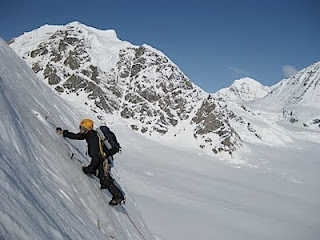
Mounteering is climbing mountain, it is also a sport & also hobby for some people. while climbing mountain people have to carry their needs with them.The great Himalayan range in Nepal has eight out of fourteen of the world's 8000 meters peak with total number of 1310 snow peaks over 6000 meters and offers the best choices for Himalayan Expendition and mountaineering in Nepal, whether the interest is simply climbing a peak or an expendition 7000 or 8000 meter peak, climbing Himalayas in Nepal has become a dream for most of the mountaineers in world.



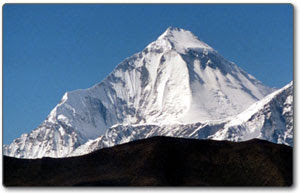 Dhaulagiri is the seventh highest mountain in the world. It forms the eastern anchor of the Dhaulagiri Himal, a subrange of the Himalaya in the Dhaulagiri Zone of north central Nepal. It lies northwest of Pokhara. across the deep gorge of the Kali Gandaki to the east lies the Annapurna Himal, home to Annapurna 1, one of the other eight-thousanders. Dhaulagiri means "White Mountain". It is one of the popular climbing peaks above 8000m. It is considered the most interesting peak among the eight thousanders.
Dhaulagiri is the seventh highest mountain in the world. It forms the eastern anchor of the Dhaulagiri Himal, a subrange of the Himalaya in the Dhaulagiri Zone of north central Nepal. It lies northwest of Pokhara. across the deep gorge of the Kali Gandaki to the east lies the Annapurna Himal, home to Annapurna 1, one of the other eight-thousanders. Dhaulagiri means "White Mountain". It is one of the popular climbing peaks above 8000m. It is considered the most interesting peak among the eight thousanders.

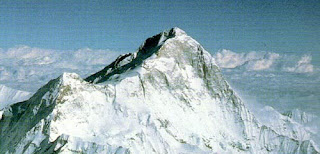 Makalu is the fifth highest mountain in the world and its located 22km east of Mount Everest, on the border between Nepal and China. one of the eight-thousanders, Makalu is an isolated peak whose shape is a four-sided pyramid. Despite it being the fifth tallest among the eight thousanders, the mountain is still virtually new. Makalu has two notable subsidiary peaks Kanchangtse or Makalu 11
Makalu is the fifth highest mountain in the world and its located 22km east of Mount Everest, on the border between Nepal and China. one of the eight-thousanders, Makalu is an isolated peak whose shape is a four-sided pyramid. Despite it being the fifth tallest among the eight thousanders, the mountain is still virtually new. Makalu has two notable subsidiary peaks Kanchangtse or Makalu 11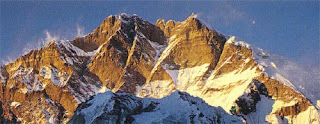 Lhotse is the fourth highest mountain on Earth and is connected to Everest via the south col. In addition to the main Summit at 8516 meters above sea level, Lhotse middle (East) is 8,414 meters and Lhotse shor is 8,383 metres. It is located at the border between Tibet (China) and Khumbu (Nepal).It is sometimes mistakenly identified as the south peak of the Everest massif. No serious attention was turned to climbing Lhotse until after Everest had finally been ascended. The first attempt on Mount Lhotse was by an international team in 1955.
Lhotse is the fourth highest mountain on Earth and is connected to Everest via the south col. In addition to the main Summit at 8516 meters above sea level, Lhotse middle (East) is 8,414 meters and Lhotse shor is 8,383 metres. It is located at the border between Tibet (China) and Khumbu (Nepal).It is sometimes mistakenly identified as the south peak of the Everest massif. No serious attention was turned to climbing Lhotse until after Everest had finally been ascended. The first attempt on Mount Lhotse was by an international team in 1955. 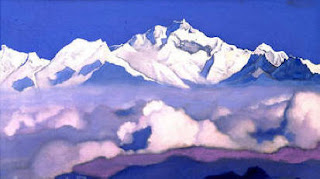 Kanchenjunga is the third highest mountain in the world, with an elevation of 8,586 (28169ft). Kanchenjunga means "The Five Treasures of Snow", as it contains five peaks, four of them over 8,450 meters. The treasure represent the five repositories of God, which are gold, silver, gems, grain, and holy books. Kanchenjunga is also called Sewalungma in the local Limbu language and is considered sacred in the Kirant religion.It is located on the border of Nepal and Sikkim, just 46 miles northwest of Darjeeling. It is the most easterly of the great 8,000-meter peaks of the Himalayas. It was first climbed by G. Band, Evans and J Brown in 1955.
Kanchenjunga is the third highest mountain in the world, with an elevation of 8,586 (28169ft). Kanchenjunga means "The Five Treasures of Snow", as it contains five peaks, four of them over 8,450 meters. The treasure represent the five repositories of God, which are gold, silver, gems, grain, and holy books. Kanchenjunga is also called Sewalungma in the local Limbu language and is considered sacred in the Kirant religion.It is located on the border of Nepal and Sikkim, just 46 miles northwest of Darjeeling. It is the most easterly of the great 8,000-meter peaks of the Himalayas. It was first climbed by G. Band, Evans and J Brown in 1955.
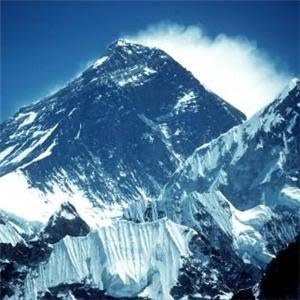 The most famous mountain peak in the Himalayas is Mount Everest. It is also known by the name of the Sagarmatha (Nepali) which means Goddess of the sky. Chomolungma or Qomolangma (Tibetan) which means mother goddess of the universe. Zhumulangma (Chinese). The highest point of earth, Mt. Everest rises majestically up to a height of 8,848m (29028ft) above sea level. Everest is named after Sir George Everest in 1865, the British Surveyor- general of India. He was the first person to record the height and location of Mt. Everest, this is where Mt. Everest got its name. Mt. Everest rises few millimeters each year due to geological forces. It was first climbed on may 29, 1953 by a Newzealander Sir Edmund Hillary and Tenzing Norgay of Nepal.
The most famous mountain peak in the Himalayas is Mount Everest. It is also known by the name of the Sagarmatha (Nepali) which means Goddess of the sky. Chomolungma or Qomolangma (Tibetan) which means mother goddess of the universe. Zhumulangma (Chinese). The highest point of earth, Mt. Everest rises majestically up to a height of 8,848m (29028ft) above sea level. Everest is named after Sir George Everest in 1865, the British Surveyor- general of India. He was the first person to record the height and location of Mt. Everest, this is where Mt. Everest got its name. Mt. Everest rises few millimeters each year due to geological forces. It was first climbed on may 29, 1953 by a Newzealander Sir Edmund Hillary and Tenzing Norgay of Nepal. 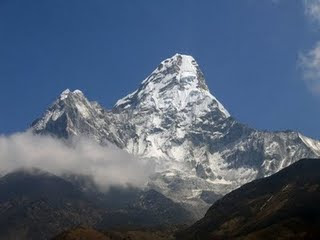 A mountain is a large land form that stretches above the surrounding land in a limited area usually in the form of a peak. A mountain is also define as natural elevation of the earth surface rising more or less abruptly from the surrounding level and attaining an altitude which relatively to the adjacent elevation, is impressive or notable. A mountain is usually produced by the movement of lithospheric plates, either orogenic movement or epeirogenic movement.
A mountain is a large land form that stretches above the surrounding land in a limited area usually in the form of a peak. A mountain is also define as natural elevation of the earth surface rising more or less abruptly from the surrounding level and attaining an altitude which relatively to the adjacent elevation, is impressive or notable. A mountain is usually produced by the movement of lithospheric plates, either orogenic movement or epeirogenic movement.